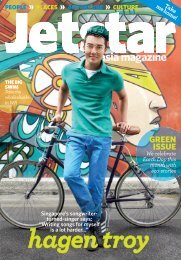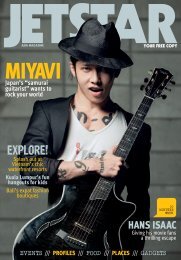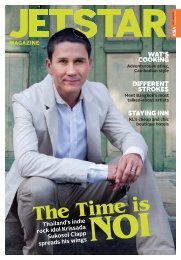You also want an ePaper? Increase the reach of your titles
YUMPU automatically turns print PDFs into web optimized ePapers that Google loves.
DISAPPEARING ASIA<br />
The triumvirate art of<br />
ukiyo-e provides a diff erent<br />
perspective of reality<br />
WORDS & PHOTOGRAPHY TREVOR MOGG<br />
Colour<br />
My World<br />
In<br />
a quiet Kyoto backstreet, just around the<br />
corner from Kennin-ji Temple, you’ll fi nd<br />
what master printer Mamoru Ichimura calls<br />
“the smallest ukiyo-e museum in the world”.<br />
Ukiyo-e, translated literally as “pictures<br />
of the fl oating world”, is an art form that<br />
fi rst came to prominence in 17th-century<br />
Japan. The “fl oating world” refers to passing<br />
moments in time, fl eeting beauty and<br />
transient pleasures. The infl uence of these<br />
charming woodblock prints spread far and<br />
wide, with the likes of van Gogh and Monet<br />
drawing inspiration from their unique style.<br />
The creation process is collaborative,<br />
comprising an artist, carver and printer.<br />
Ichimura-san learned how to create ukiyo-e<br />
prints by observing his grandfather. “I took<br />
over from him more than 50 years ago.<br />
I opened the museum a decade ago as<br />
22 FEBRUARY /MARCH <strong>2011</strong><br />
I wanted to spread the word about this<br />
wonderful art which sadly is dying out.”<br />
Ichimura-san’s workshop is a chaotic clutter<br />
of paint pots, brushes, carved wood blocks<br />
and paper, but when he settles down on the<br />
tatami fl oor to work, a sense of order prevails.<br />
It quickly becomes apparent that extreme<br />
precision and deftness of touch is essential.<br />
After wetting the carved woodblock he<br />
carefully inks its entire surface using a<br />
horsehair brush. Next, he takes a sheet of<br />
lightly dampened paper, specially prepared<br />
so that it absorbs the ideal amount of ink, and<br />
gently lays it over the woodblock, ensuring it<br />
lines up exactly with the carved marks at the<br />
bottom of the block. Using a baren, a circular<br />
pad, he presses hard but evenly on the paper<br />
to ensure the ink is properly transferred. Once<br />
satisfi ed, Ichimura-san slowly peels the freshly<br />
Jetstar Asia fl ies to Osaka via Taipei daily, book online at Jetstar.com<br />
inked paper from the block. A diff erent block is<br />
used for each colour added, with diff erent parts<br />
of the carving raised for each individual colour.<br />
The master printer takes great pride in<br />
demonstrating his skills to visitors. “It’s a<br />
pleasure to share my passion for this art, and<br />
it allows me to meet people from all over the<br />
world. I’ve never been out of Japan, but through<br />
my visitors I’ve been all over the world.”<br />
Now 67, Ichimura-san has no plans to retire.<br />
“There are less than 50 printers like me left in<br />
the whole of Japan. I enjoy it so much that I’ll<br />
continue for as long as I can.”<br />
Ichimura-san has a large collection of prints<br />
on show at his museum. Visitors can watch<br />
him at work, and even have a go themselves.<br />
151 Komatsu-cho, Higashiyama-ku, Kyoto,<br />
tel: +81 (0)75 561 7355
















